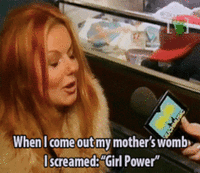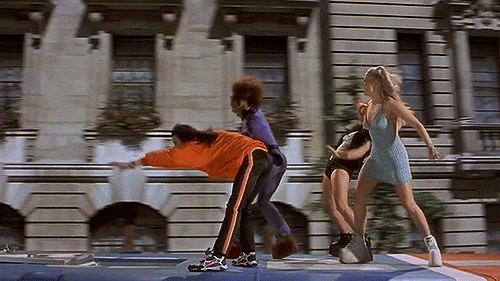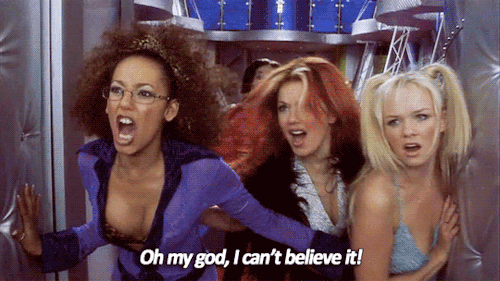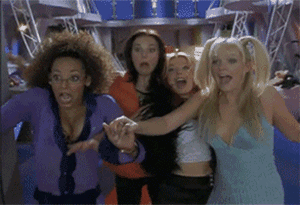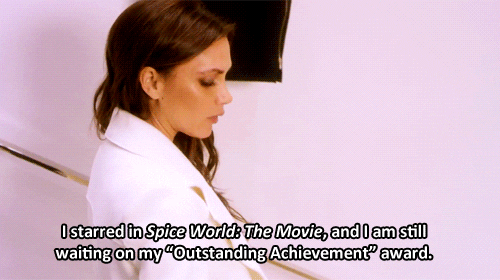Those are "The Rules"!
Spiceworld as a consumer ecosystem and Spice World as metafictional absurdity
Welcome to today’s weekend edition of the letter. If you found Nicstalgia on Substack and are not already subscribed, please do so!! 💃🏻
I have always been a massive Spice Girls fan. Their campy enthusiasm, maximalist aesthetic, and diehard loyalty to never-ending friendship shaped my entire personality. But even more than a band, the Spice Girls was a “prolific marketing phenomenon”. Their omnipresence in the 1990s – the decade with capitalism, globalism, and neoliberalism as dominant structures – inspired a powerful shift toward the ‘artist-as-a-brand’ model that is commonplace today, although their lucrative brand sponsorship deals, hundreds of product tie-ins, and excessive merchandising eventually fatigued consumers. Spiceworld is not simply the name of the band’s second album, it’s a consumer ecosystem that includes music, movies, video games, dolls, school supplies, cameras, lollipops, chocolate eggs, and much, much more.1
This IP universe engages its fandom with instantly recognizable characters, cross-media presence, values, and language. Although its central mantra “Girl Power” expresses solidarity, autonomy, authority, and ownership through both a feminist and postfeminist lens, Spiceworld’s version hinged upon empowerment, self-expression, and consumerism rather than social mobilization and political activism. As much as the Spice Girls enjoy sticking up a middle finger to the patriarchy, their manager was a total #GIRLBOSS. He egregiously committed the number one Gen X sin: selling out. The band’s worldwide overexposure maximized profits to a previously inconceivable extent, though he claimed the financial gain was simply a byproduct of effective positioning. “It was about using [brand sponsors’] money to make my group famous, and then they’d make lots of money anyway.” This theme is explored in the movie Spice World (1997), a metafictional satire about the lengths to which people attempt to capitalize off of the girls’ fame. It’s soundtracked by the album Spiceworld (1998), and features a Spice World movie subplot, ultimately existing to promote Spiceworld (the album AND the consumer ecosystem).
Spice World has a loose plot and is a chaotic smorgasbord of sketches, celebrity cameos, musical numbers, dream sequences, surreal encounters, and meta-commentary. Though they play exaggerated versions of themselves, “Sporty”, “Posh”, “Ginger”, “Baby”, and “Scary” personas, given to them by a “lazy journalist”, are caricatures to begin with. The grand majority of Spice World’s one hour and thirty three minutes is spent resisting others’ impositions on their boundaries and attempts to control their time, image, relationships, and creative vision. Not to mention, they also have people constantly chasing them, literally and figuratively. In the literal sense, they are followed by an amateur documentary film crew and an unsettling paparazzo who vanishes under a party table disguised as a fruit platter, emerges from a toilet bowl (how), and breaks into a hospital with a camera before being tackled to the ground and realizing his life has been a meaningless lie. Figuratively, they are followed by tabloid newspaper owners, Hollywood writers, fashion editors, and even literal aliens, whose economic, social, or cultural currency is dependent on the girls’ success or failure.
One of the many subplots showcases persuasive appeals to the girls’ manager Clifford (Richard E. Grant) by Martin Barnfield (George Wendt) and Graydon (Mark McKinney), two bumbling, opportunistic American screenwriters.23 They desperately pitch increasingly absurd movie plot ideas, all while these scenarios are actually playing out in the movie itself. The thematic elements, no matter how far-fetched, are consistently justified by “The Rules”. The Rules refer to the formulaic conventions of mainstream filmmaking – digestible plot, linear structure, cohesive narrative, archetypal characters. The Americans represent the Hollywood industrial complex, a system that expects films to follow a specific, replicable format to drive maximum profit and assert cultural dominance. Spice World is constantly bending, contorting, and inverting the rules by which it plays.
The Rules:
There’s a high-speed race against time. Victoria recklessly drives the Spice Bus to get to the girls’ show at Royal Albert Hall in time. Pigeons are flying everywhere as she swerves through London’s busy streets. Time is crunched further by slow Sunday drivers – and it’s only Saturday!
There’s a vulnerable, life-or-death scenario. The girls are on suddenly on top of the fast-moving bus, holding onto each other for dear life. Why? The Rules.
There’s an action sequence that diffuses the immediate conflict. A Mini Metro of nuns pulls in front of them. Victoria’s sudden slam on the brake propels the girls through the roof and back into the bus.
An even more dramatic, life-or-death scenario immediately comes into focus. They’re coming up on the Tower Bridge as the road is rising in front of them to let a boat pass through. They can’t believe it!!!!!!
Sanity is questioned as they are faced with a seemingly insurmountable obstacle, yet the challenge is accepted. “Are they crazy enough to jump the gap? Hey baby, these are the Spice Girls!!! OF COURSE they’re gonna go for it!!!!”
The challenge is completed. A 5-ton London bus sails through the air at 70 miles per hour! Or rather, a toy bus on a miniature replica of the Tower Bridge, because trying to stage that would be very expensive.
There is no falling action; immediately, there is another life-or-death realization. Just when you think they’re safe, they discover the bomb on the bus.
Why? Those are The Rules. At this point, Martin breaks out in a fit of anger against Graydon, who’s been reciting the diegetic dialogue. “My God, I’ve had ENOUGH of The Rules! No more! They’ve suffered enough! PLEASE!” Graydon relents, describing a realistic scenario – the girls get to the concert venue, clomp up the steps, hurdle down the corridor, and burst through the dressing room door. The three men stare at the door in silence for an entire five seconds and nothing happens. The movie pitch, and Clifford’s reality, depend on the Spice Girls barging in through that door. But they don’t. Clifford’s pissed and chokes Graydon, who manages to squeak, “I’ll rewrite it!”
Watch the full spectacle of The Rules:
By the final scene, Clifford finally accepts Martin and Graydon’s pitch. The men celebrate the deal by dancing along enthusiastically to “Spice Up Your Life”. The ending credits play with a nonlinear time construct; they show the Spice World actors arriving on the movie set for the first time – yes, the very movie that the audience just watched. The Venn Diagram between the movie pitch and the movie plot is a circle.
Ultimately, the Spice Girls played by The Rules while winking at the camera. Spice World follows the formula, mocks it, and markets it all at once. Its metafiction and post-ironic humor don’t break the system, but rather shows just how bendable it is.4 They didn’t dismantle the Hollywood playbook – they turbocharged it, writing a new norm where self-parody and self-promotion could become one.
Nicstalgia is a reader-supported publication. Huge thank you to the people who go above and beyond to support my work: Janine, Marie, Liv, CY, Chet, Jack, Matthew, and Matthew! (Not a typo lol.) À la Jessica Simpson, I’m gonna love you forever 💐💐💐 If you enjoy Nicstalgia, please consider upgrading so I can continue writing the most fun newsletter about offbeat, obscure, and niche pop culture.
Newsletter ☆ Instagram ⟡ Website ♡ Podcast Archive ☆ Fitness Schedule ⟡
There was an imported memorabilia store in the mall that carried various licensed IP (Hello Kitty, Sailor Moon, Pokemon, etc.). My Grammy, fully aware of my devotion to the Spice Girls, went in there and swept the shelves. I had not one full set of Spice Girls dolls, but two.
RIP George Wendt. Most people know him from Cheers or perhaps even as Macaulay Culkin’s pissed off dad in Michael Jackson’s “Black and White” music video. I primarily associate him with Spice World.
Also not sure why one of them gets a last name and the other one doesn’t. One of art’s great mysteries.
I strongly stand by my statement that Aries legend Victoria Beckham is the comedic genius of our time.







